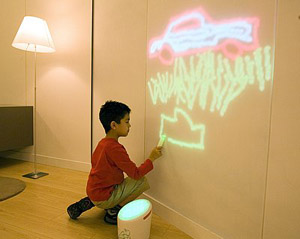
Although the event at which the technology is described appears to be have happened some months ago, I just saw this video on YouTube about a Philips project called "Drag & Draw." It appears to be a projector and a motion-tracking camera that's tuned to specific colors in an RGB LED pointer. The colors are selected using a "paint bucket" of glowing LEDs. It seems to be a small-scale version of the Graffiti Research Lab's LASER Tag project (though predating it, the GRL project got more media coverage recently), and not unlike Golan Levin's many projects.
Philips describes that with Drag & Draw, "the entire home becomes a virtual canvas for expression and play for young children, thanks to a magic brush, a magic eraser, a magic wand, and a laser projection bucket." That's a lot of magic.
In the YouTube video they go further, "You can cast magic onto the drawing and it will come to life." Their video scenario is fanciful with how this animation works, but as Levin shows, there are many precedents for this kind of static-to-dynamic drawing.
Of course I find it interesting that they're using magic as a metaphor to describe functionality, but I suspect that this is primarily to explain it to themselves and to other adults. If their audience is genuinely small children (and why not people who need a white board replacement?), the kids probably don't need the explanation that it's magic. It just is, it works the way it works. How does glue work? Does it matter when you're making a collage? Same here.
Also, speaking of wands, in the same show Philips showed the "uWand" that they describe as:
a Philips vision of a revolutionary way of accessing and managing content, enabling the user to interact with their digital environment in a natural and self-expressive way. A simple stroke of the uWand allows users to intuitively point at a device and to scroll, select, play and move elements.
This is the first pairing of the "u" prefix (which typically implies "ubiquitous" in the same way that "i" originally implied "Internet" and now implies something like "interactive" or "me") and "Wand." Magic and ubiquitous computing. From Philips, no less.




It is interesting that you mention that children don't need the magic metaphore. How can you explain this to a child though? Most adults wouldn't even understand this very well.
I would imagine that if this magic metaphore starts to be used often enough, adults will teach it to their children, and people might grow up in an environment lacking a basic understanding of the tools around them. To an extent that exists already, but all this ubiquitous technology is making it worse.
I wonder if first adopters of this sort of thing fall into two groups. Those who are in a technology field and quickly grasp how things work and those who don't understand how the engine in their care works and don't care either.